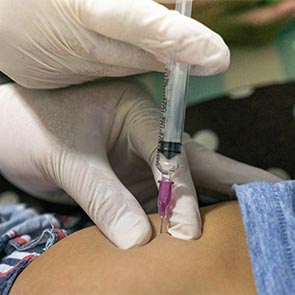Intra-Articular Hip Injections in Midland Park, NJ

Is chronic hip pain or hip osteoarthritis disrupting your health, movement, or quality of life? You may benefit from intra-articular hip injections, a pain relief treatment that includes injecting steroids, growth factors, or stem cells to reduce or relieve your hip pain.
Painful hip conditions don't have to disrupt your lifestyle and prevent you from the activities you enjoy. To speak with an intra-articular hip injection specialist today in Midland Park, call (201) 806-6099 or contact Medwell Orthopedics & Functional Medicine for Men & Women online.
What Are Intra-Articular Hip Injections?
Intra-articular hip injections are a diagnostic and pain relief treatment option for patients suffering debilitating hip pain or hip osteoarthritis. The goal of this treatment is to diagnose the specific pain source and provide long-lasting pain relief with a second intra-articular hip injection of steroids, growth factors, or even stem cells.
How Are Intra-Articular Hip Injections Performed?
Intra-articular hip injections deliver corticosteroids, growth factors, or stem cells directly into the hip joint.
Steroid injection
Using imaging guidance like x-ray, fluoroscope, or ultrasound, your healthcare provider will inject a contrast dye into the hip joint to identify the affected pain area.
As allergies to shellfish, iodine, or contrast dye can cause a painful reaction, discuss any allergies with your healthcare provider before undergoing an intra-articular hip injection.
After confirming your pain site, your provider will perform a diagnostic test by injecting a local anesthetic to discover whether it disrupts your pain. If the injection relieves your pain or makes your pain manageable, your physician may then give you a therapeutic version of an intra-articular hip injection.
This involves injecting a corticosteroid that reduces inflammation and decreases or eliminates pain. Using imaging guidance, your provider will inject the medication directly into your affected area.
Intra-articular hip injections may cause arm or leg weakness or numbness, making driving difficult or unsafe, so be sure you have someone drive you home after the procedure. The pain may return a few hours after the procedure as the local anesthetic wears off, but it should subside shortly after.
The time-released corticosteroid typically takes effect in a day or two. This procedure may be repeated 3-4 times per year. Physical therapy is recommended to strengthen your muscles and complement your injection treatments.
Growth factors
Your blood is mainly composed of a liquid called plasma, which contains microscopic components: red cells, white cells, and platelets. Platelets are crucial to the blood clotting process and contain many proteins, called growth factors, which play a vital role in healing injuries.
Platelet-rich plasma contains many more platelets than typically found in blood. Platelet concentration (and growth factors) can be up to ten times greater than that of typical blood samples, so it may promote soft tissue cell regeneration and control inflammation, reducing or eliminating pain.
To create PRP, your provider will draw your blood and separate the platelets in a centrifuge. The separation process is repeated until a platelet-rich serum is created. Then, using state-of-the-art ultrasound guidance for precision and accuracy, this serum is injected directly into your damaged tissue.
Stem cells
The stem cells in your body are charged with regenerative potential - they just need to be stimulated. The injured cells in your skin, bones, muscles, ligaments, tendons, and connective joints send out signals. When released into damaged areas, mesenchymal stem cells (MSCs) respond to those signals, migrating to the injured tissue and releasing proteins that nourish and stimulate your own cells to begin regenerating.
On the day of your therapy, your medical provider will give you a local anesthetic to prevent any pain during the injections. However, your medical provider will not apply large amounts of local anesthetic - studies have shown this may damage the stem cells.
The mesenchymal stem cells will be injected into your pain site. You should feel little or no pain from these injections. The process typically takes about thirty minutes.
Once your practitioner injects them, the MSCs cells dock next to your cells and release growth factors, cytokines, and chemokines which then may:
- activate T-cells to secrete proteins
- open up your blood vessels and form new ones
- move cells out of your blood vessels and into the tissues surrounding them
- stimulate your cells to regenerate your tissue
- inhibit your inflammation
- regulate your immune system
Depending on your age, body type, genetics, and severity of the injury, live nucleated cells may continue producing human growth factors for weeks, sometimes even months. As with all medical procedures, success rates will also vary depending on all these factors.
Your post-injection recovery time will be minimal. It requires waiting for the local anesthesia to wear off. Your provider will discuss your expectations and offer advice on your unique case. You may then return to your usual daily activities, but you should avoid heavy exercise or stress. Rest is advisable.
Where Do Stem Cells Come From?
Although there are two sources of regenerative mesenchymal stem cells, worldwide clinical trials have homed in on the most effective and least risky source: umbilical cord cells.
Adult Bone Marrow or Fat
These stem cells are drawn from a patient's bone marrow or fat intravenously, then injected into damaged tissue, where they take on the properties of the surrounding cells and stimulate regeneration. Adult bone marrow harvested during this invasive procedure may contain up to 100,000 defective stem cells, so this option is no longer widespread.
Umbilical Cord
Mesenchymal cells derived from umbilical cords and cord blood are today's leading source of viable stem cells.1 These cells are harvested from an umbilical cord shortly after a mother gives birth, then stored in a donor bank until they are needed.
Each umbilical cord can provide 500,000 viable mesenchymal stem cells - a huge improvement over older stem cell collection methods. Umbilical cord blood (UCB) is considered most suitable because it is free from ethical complications, and easy to isolate via non-invasive methods. UCB yields large amounts of MSCs and possesses strong immunosuppressive potential.
Other advantages include:
- a non-invasive collection procedure
- lower risk of infection
- low risk of teratoma (a tumor made up of several types of tissue)
- multipotent (can develop into more than one cell type)
- low chance of provoking an unwanted immune system response
When a pregnant woman decides she doesn't want to keep and store her child's umbilical cord, her OB/GYN asks whether she would like to donate it. After signing an informed consent form, taking a blood test, and undergoing a thorough medical and social history review, the new mother becomes a donor.
After the child is born, the umbilical cord blood is collected in a sterile cord blood collection bag and sent to a lab, where it is processed within 48 hours using proprietary methods. After all lab reports have passed the regulatory requirements, the umbilical cord stem cells are distributed.
Are Umbilical Cord Stem Cells FDA-approved?
So far, the FDA has approved only one stem cell product: umbilical cord blood-derived hematopoietic progenitor cells (blood-forming stem cells) which are used for certain indications.
While there is enormous promise in stem cell therapies and thousands of ongoing experimental applications trying to establish efficacy, stem cell treatments do not yet meet the scientific standards for FDA approval. The science in each use is still in developmental stages.
The pace of the approval process appears to be picking up. In 2018, the FDA's commissioner and research director reported that the agency will be incorporating some "new concepts for how small investigators and firms can seek and meet the approval standard for products through efficient expedited pathways."
Before undergoing stem cell therapies, always evaluate the latest developments on the FDA's human tissue website and speak with your healthcare provider.
What Are the Potential Side Effects of Intra-articular Hip Injections?
Each treatment option presents the possibility of side effects.
Steroid Injections
- leg muscle weakness or numbness
- dizziness
- mild headaches
- mild discomfort at the injection site
- acne
- insomnia
More serious side effects are rare, but if they occur, speak with your doctor or seek emergency medical care immediately. These can include:
- severe pain at the injection site
- leg weakness that gets worse or lasts longer than 8 hours
- severe redness, swelling, or discharge at the injection site
- fever, chills, nausea, or vomiting
- bowel or bladder discomfort or dysfunction (difficulty controlling either)
Growth Factors
Because platelet-rich plasma treatment injects your own blood plasma, it typically causes mild or no side effects. You may experience:
- a feeling of heaviness at the injection site
- pain, bruising, swelling, or discomfort at the injection site
- a mild headache
Stem Cells
Stem cell injections are usually safe. But like any medical procedure, side effects may occur in some patients.
Complications from transplants using your own stem cells include bleeding, anemia, infections, inflammation of lung tissue, and liver damage.
Side effects from using donor stem cells include graft-versus-host disease – the rejection of a donor's transplant causing side effects that range from hair loss to liver damage and is treated with a combination of antibacterial, antifungal, and antiviral drugs, and steroids that weaken the immune system.
Conversely, mesenchymal stem cells from umbilical cords apply healthy infant cells, so few side effects have been observed. However, as with any other injection procedure, there is a very small risk of bacterial infection not associated with the cells themselves.
Reserve Your Appointment Today
Hip pain or osteoarthritis doesn't have to control your life. Treatments like corticosteroid, growth factor and stem cell injections may help reduce or relieve your chronic pain, helping to improve your health and quality of life.
To discover how these treatments can reduce or relieve your hip pain, speak with an intra-articular hip injection specialist in Midland Park today by calling (201) 806-6099 or contact Medwell Orthopedics & Functional Medicine for Men & Women online.
Sources
1. Nagamura-Inoue, Tokiko. "Umbilical Cord-Derived Mesenchymal Stem Cells: Their Advantages and Potential Clinical Utility." World Journal of Stem Cells, vol. 6, no. 2, 2014, p. 195., doi:10.4252/wjsc.v6.i2.195.
Medwell Orthopedics & Functional Medicine for Men & Women
Address
33 Central AveMidland Park, NJ 07432
(201) 806-6099
www.BergenCountyDoctors.com
Hours
Mon:
8:00 am - 8:00 pm
Tue:
2:00 pm - 7:00 pm
Wed:
8:00 am - 6:30 pm
Thu:
8:00 am - 1:00 pm
Fri:
8:00 am - 6:30 pm
Sat:
9:00 am - 1:00 pm
Sun:
By Appointment Only

